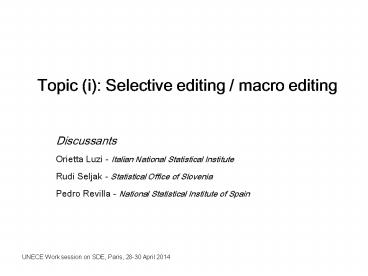Topic (i): Selective editing / macro editing - PowerPoint PPT Presentation
Title:
Topic (i): Selective editing / macro editing
Description:
Topic (i): Selective editing / macro editing Discussants Orietta Luzi - Italian National Statistical Institute Rudi Seljak - Statistical Office of Slovenia – PowerPoint PPT presentation
Number of Views:109
Avg rating:3.0/5.0
Title: Topic (i): Selective editing / macro editing
1
Topic (i) Selective editing / macro editing
- Discussants
- Orietta Luzi - Italian National Statistical
Institute - Rudi Seljak - Statistical Office of Slovenia
- Pedro Revilla - National Statistical Institute of
Spain
2
Background
- The adoption of selective editing / macro editing
approaches can significantly improve the
efficiency of the data editing process - This is especially true in the case of business
surveys where usually a small amount of
measurement errors have a decisive influence on
the final results and therefore the appropriate
usage of selective editing and macro editing
techniques can significantly reduce the cost of
the data editing process with no major impact on
the quality of the final results - Developing tools implementing selective editing
models/functions may validly support further
harmonization and widening use of efficient
editing strategies in NSIs
3
Topic contents
- Practical implementation of local and global
score functions - Integration of selective editing / macro editing
techniques within the statistical process - Tools to support selective editing / macro
editing, including visualization approaches - Validation of selective editing strategies,
inference issues - Editing of unstructured data
4
Long Presentations
- Italy - Use of administrative data for selective
editing the case of business investments - Spain - Score Functions under the Optimization
Approach - United Kingdom Maintenance of Selective
Editing in ONS Business Surveys
5
Short Presentations
- Sweden Experiences from Selective Data Editing
at Statistics Sweden - France Selective Editing Techniques and
Seasonal Adjustment of Short-Term Economic
Indicators - France Using R-indicators to monitor household
surveys and prioritize data collection an
application to the 2010 Household Wealth survey
in France - Japan An Assessment of Automatic Editing via
the Contamination Model and Multiple Imputation - United States Text Analysis Tools for Editing
and Verification - Sweden Adjusting for Remaining Measurement
Errors after Selective Editing
6
Short Presentations
- Sweden Adjusting for Remaining Measurement
Errors after Selective Editing (T. Laitila, A.
Norberg) - Model-based approach for bias correction of
estimators due to the remaining errors in
selective edited data sets, where the observed
measurement errors in the edited units are
related to their scores. - The estimated models are used to predict
measurement errors in unedited units and their
associated bias. - Experimental application to data of the sample
survey on establishments and their salary
payments to employees carried on at Statistics
Sweden.
7
- Topic (i) Selective editing / macro editing
- Discussion
8
Overall summary
- Session papers provide a wide-ranging overview of
current research and development activities in
the area of selective / macro editing carried out
at various NSIs with the aim of enhancing the
efficiency of survey editing strategies - Theoretical formalizations of the selective
editing paradigm are proposed, in a situation
where no accepted theory has been developed in
this area yet demanding modelling problems come
out from presentations - The need of a common theoretical evaluation
framework for quality assessment of selectively
edited data is an area requiring further
research at also an international perspective - Issues related to the development and
dissemination inside NSIs of generalized
IT-tools for selective editing are discussed,
with specific attention to those relating to
applicability, maintenance and optimization of
the implemented methods/models - New application contexts where selective / macro
editing principles can contribute to most
efficient statistical production processes are
explored
9
Points for discussion
- Integrating selective / macro editing in existing
EI process - Advantages (increased efficiency, burden
reduction,) - Costs (re-design of processes, models/parameters
maintenance/update due to changes of
populations/information contexts, ) - Cultural issues (changes in attitude needed,
importance of support by the survey staff,
importance of constant training and education,) - Countries experiences
- Papers from Italy, Japan, UK, Sweden (A. Norberg)
10
Points for discussion
- Formalization of selective editing
- Ad hoc methods VS theoretical frameworks
- How to estimate the model parameters?
- How do we apply the developed frameworks in
practice? - Papers from Italy and Spain
UNECE Work session on SDE, Paris, 28-30 April 2014
Topic (i) Selective editing / macro editing
10
11
Points for discussion
- Standard tools for selective editing
- Advantages (costs savings, harmonization, easy to
document and to update, ) - Drawbacks (specificity against generalization,
validity of models assumptions, black-box
effect, .) - International co-operation, sharing solutions
- SeleMix (papers from Italy, Japan), Selekt
(papers from Sweden, UK)
12
Points for discussion
- Selective and macro editing and administrative
data - Potentials (use of admin data as auxiliary
information for error modeling/error
detection/error correction) - Direct use of admin data for estimation purposes
feasibility, costs, role of selective / macro
editing - Paper from Italy
13
Points for discussion
- Assessing the validity of a selective / macro
editing strategy - Which indicators, quality measures, evaluation
approaches - Inference and quality assessment under
selectively edited data - Countries experiences
- Paper from Italy, Sweden (Laitila-Norberg)
14
Points for discussion
- New, innovative approaches in selective / macro
editing strategy - Editing of unstructured data by using text
analyses tools - Using R-indicators for prioritization of
follow-up - Countries experiences
- Paper from United States , France (Merly-Alpa)































![READ[PDF] Basic Cardiac Rhythms: The Visual Nurse's Guide 3RD EDITION PowerPoint PPT Presentation](https://s3.amazonaws.com/images.powershow.com/10082151.th0.jpg?_=20240722124)